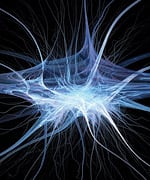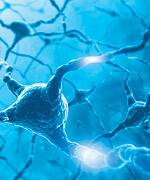Life Extension Magazine®
Some facts are so terrifying that people pretend they are not real. A recent survey found Alzheimer's is the second most feared disease...cancer ranked number one.1 Yet most cancers are curable, while Alzheimer's insidiously kills every one of its victims. Alzheimer's incidence increases exponentially as humans age. If we make it to 80-85 years, Alzheimer's prevalence rises to a startling 25%-30%.2,3 It is unsettling to think that our odds of developing Alzheimer's are so high, but there is reason for optimism. Scientists have identified factors that increase Alzheimer's risk. This enables enlightened individuals to neutralize underlying causes of Alzheimer's and spare themselves the frightening statistical probabilities faced by the general population. Life Extension® members do a lot to reduce senility risk, such as suppressing destructive inflammatory reactions in the brain (with nutrients like curcumin),4-7 while ingesting structural components required by brain cell membranes (such as DHA from fish oil).8-11 In a remarkable discovery, the loss of synapses has been shown to occur early in the process of Alzheimer's and may trigger onset of the disease.12 Fortunately, a highly absorbable form of magnesium not only protects the integrity of delicate brain synapses, but also increases synaptic density, thus helping to reverse the structural loss of this critical brain component.13 What Is a "Synapse?"Our brain consists of about 100 billion cells called neurons. In order for neurons to communicate in a way that enables you to exist, they must connect to one another. A synapse is the connection that allows information to pass from one neuron to the next. Your synapses control electrical impulses and the release of neurotransmitters between neurons. Brain synapses serve as a junction that enables neurons to pass signals in a synchronized/organized pattern. Synapses, as you might imagine, are essential to neuronal function. Not only are synapses crucial to short-term memory in the young, but their structural integrity is imperative in aging individuals seeking to stave off cognitive impairment and senility. What Happens When Our Synapses Degrade?
Alzheimer's disease is characterized by the pathological accumulation of non-functioning plaque in neurons and loss of normal neurotransmitter flow between neurons. Before neurons encounter this severe damage, scientists have found a marked decline in synaptic density. This loss of synaptic density causes a decline in neuronal connectivity that strongly correlates to the cognitive impairment observed in Alzheimer's disease.14-17 In fact, a consistent finding in the brains of Alzheimer's victims is a significant loss of synaptic contacts. This led one group of researchers to conclude: "...synapse loss is an early event in the disease process and suggests that mild cognitive impairment may be a transitional stage between early Alzheimer's disease and no cognitive impairment, with synaptic loss a structural correlate involved in cognitive decline."18 Another group of scientists looked at synaptic decay and concluded that it "may represent an early and subtle alteration able to trigger the development of senile plaques and neurodegenerative events."19 There are about 5 million Americans suffering from Alzheimer's today. That number will spike upward to 8.6 million by the year 2030 and to an astounding 16 million by 2050.20 America does not have the economic or human resources to care for this many Alzheimer's victims. A compelling need exists for an intervention that prevents the downward cascade of neuro-degeneration that will manifest as Alzheimer's in 25%-30% of aged individuals.21 Magnesium Protects and Restores Synaptic DensityIn a series of unprecedented laboratory experiments, a highly absorbable form of magnesium was shown to not only increase magnesium blood levels, but it also substantially increases magnesium brain concentrations.13 In response to this elevation in cerebral magnesium, there were significant increases in synaptic density and corresponding improvements in synaptic functioning and neuronal signaling.13 These improvements in synaptic structure and function translated into improvements in measurements of cognitive function. Restoration of Short- and Long-term MemoryUsing this highly absorbable magnesium (magnesium-L-threonate), scientists were able to obtain remarkably high brain magnesium concentrations compared to other forms tested. In one study, just 24 days oral supplementation with magnesium-L-threonate produced an increase in cerebrospinal magnesium sufficient to boost short- and long-term memory scores. Other forms of magnesium (such as magnesium chloride, magnesium citrate, magnesium glycinate, and magnesium gluconate) did not significantly elevate brain magnesium compared to the control group.13,22 Another test on aging animals (rats) that had suffered memory decline showed that magnesium-L-threonate could reverse the kind of cognitive dysfunction that occurs in normal aging humans. The animals had magnesium-L-threonate added to their drinking water for one month. The findings showed improvements of 18% in short-term memory in animals treated with magnesium-L-threonate. In a validated test for long-term memory, these same animals supplemented with magnesium- L-threonate exhibited 100% enhanced performance.13 Enhancement of Spatial Short-term Memory
Spatial memory relates to how an organism functions in a particular space. In this study, groups of animals were reward-trained in a maze. At the end of training, some groups received magnesium-L-threonate while the others served as controls. In the young animal control group, there was no change in ability to navigate the maze. In young animals supplemented with magnesium-L-threonate, there was better performance (up to 13% improvement). Aged animals supplemented with magnesium-L-threonate performed 18% better than the aged control group (not given magnesium-L-threonate).13 The scientists stated that a significant improvement in choice accuracy was apparent 6 days after initiation of magnesium-L-threonate supplementation and this improvement continued for more than 30 days after cessation of magnesium-L-threonate in young animals. This finding helps validate the longer-term benefit of the increase in synaptic density. Strikingly, spatial performance of aged animals was re-enhanced within 12 days of re-initiation of magnesium-L-threonate supplementation.13 The scientists concluded that magnesium-L-threonate treatment can enhance the spatial working memory in young and aged rats.13 Enhanced Long-Term Spatial PerformanceYoung and old animals underwent maze training with a delay interval. Animals supplemented with magnesium-L-threonate learned to find the hidden platform in the maze faster than non-supplemented animals. In addition, the degree of learning ability enhancement in the aged animals was greater than in young animals. This makes sense since aged animals suffer from loss of synaptic density that magnesium-L-threonate has been shown to restore.13 To test the long-term spatial memory, a second trial test was performed 24 hours later. The unsupplemented "control" group forgot how to perform in the maze, whereas young and aged animals supplemented with magnesium-L-threonate retained their ability to navigate the maze. This might be equivalent to an older human being able to find their car in a crowded parking lot. In statistical terms, supplementation with magnesium-L-threonate resulted in long-term spatial memory improvement of 122% in younger animals - and 100% in older animals.13 The researchers concluded, "magnesium-L-threonate significantly enhanced hippocampus-dependent spatial learning and memory in both young and aged rats."13 Correlation Between Increased Synaptic Density and MemoryTo verify that the mechanism behind these improvements in memory and cognitive performance was due to increased density of the synapses, studies were done to precisely measure the various synaptic structural components in the brain. The rats supplemented with magnesium-L-threonate showed across-the-board improvements in synaptic protein expression, function, and structure, along with long-term potentiation of synaptic strength.13 Aging and Synaptic DeclineSeveral studies indicate that synaptic connections decline in the portion of the brain essential for memory, and the degree of loss of synapses correlates with the impairment of memory functions.23-25 To evaluate the impact of magnesium-L-threonate on old animals, one group received the supplement while an unsupplemented group served as controls. After only 1 month, autopsy findings showed synaptic density was 67% higher in the group supplemented with magnesium-L-threonate. This study showed that even in old animals, magnesium-L-threonate increased the density of synaptic components essential for youthful neurotransmitter release.13 Critical Importance of Magnesium
Since 1981, Life Extension has recommended high-potency magnesium supplements. The reason is that magnesium is perhaps the most deficient mineral in the American diet. With all the research linking low magnesium intake with high cardiovascular risks, this mineral would appear to be a simple way to help counter the heart attack and stroke epidemic plaguing aging Americans. A government study shows a staggering 68% of Americans do not consume the recommended daily intake of magnesium.26 Even more frightening are data from this same study showing that 19% of Americans do not consume even half of the governments recommended daily intake of magnesium.26 Is it any wonder that disability and death from heart attack and stroke are the nations leading killers? In the early 1980s, the Life Extension Foundation® was criticized by mainstream doctors for recommending high doses of magnesium relative to calcium. We even had our magnesium supplements seized by the FDA because we presented evidence that it could help prevent heart attack. While the FDA refuses to recognize the value of magnesium, the National Institutes of Health (NIH) published the following on its website: "Magnesium is needed for more than 300 biochemical reactions in the body. It helps maintain normal muscle and nerve function, keeps heart rhythm steady, supports a healthy immune system, and keeps bones strong. Magnesium also helps regulate blood sugar levels, promotes normal blood pressure, and is known to be involved in energy metabolism and protein synthesis. There is an increased interest in the role of magnesium in preventing and managing disorders such as hypertension, cardiovascular disease, and diabetes."27 The nations leading health agency (NIH) acknowledges magnesiums critical role in keeping us alive, yet the FDA has done everything it could to keep this mineral out of Americans bodies. The death toll from the FDAs censorship of magnesium is beyond comprehension. Potential to Stave Off Health Care Cost CrisisThe cost of caring for those stricken with Alzheimer's and other neurological disorders is adversely impacting this nations health care system. The enormous burden placed on families with senile loved ones destroys their productivity during critical working years. Magnesium supplements are widely available, but many do not provide optimal absorption into the bloodstream and virtually none into the brain to restore critical synaptic density. Widespread supplementation with magnesium-L-threonate has the potential to slash the incidences of many neurological disorders afflicting the aging population. Clinical trials are now beginning to assess whether magnesium-L-threonate functions as well in aging humans as it does in rodents. With the wealth of data validating the systemic benefits of magnesium, those who dont want to wait years for the human studies to conclude should consider supplementing with 2,000 mg each day of magnesium-L-threonate. Based on animal data, noticeable improvements might occur within a relatively short time.
Battling Government Inertia
Even if human trials corroborate the unprecedented laboratory research you have just read about magnesium-L-threonate, there might not be enough money available to have the FDA approve it for conventional human use. Life Extension is on the front lines battling these kinds of bureaucratic roadblocks that keep safe and effective natural therapies out of the reach of most Americans. The issue of Life Extension Magazine® youll receive in January 2012 provides a technical review of the multiple mechanisms by which magnesium-L-threonate has been shown to reverse neurologic decay. We are introducing it now so that members who want to try it are not delayed. Once a year, we discount all of our advanced formulas so that members can stock up at extra low prices. We hope youll take advantage of these Super Sale prices to obtain premium-grade supplements to protect your health today, while helping us battle the oppressive forces of censorship and over-regulation that are suffocating medical innovation. For longer life,
William Faloon | |||||||||||||
| References | |||||||||||||
| 1. Available at: http://www.webmd.com/Alzheimer's/news/20110720/Alzheimer's-feared-misconceptions-common. Accessed August 1, 2011. 2. Ott A, Breteler MM, van Harskamp F, et al. Prevalence of Alzheimer's disease and vascular dementia: association with education. The Rotterdam study. BMJ. 1995 Apr 15;310(6985):970-3. 3. Hebert LE, Scherr PA, Bienias JL, Bennett DA, Evans DA. Alzheimer disease in the US population: prevalence estimates using the 2000 census. Arch Neurol. 2003 Aug;60(8):1119-22. 4. Ray B, Lahiri DK. Neuroinflammation in Alzheimer's disease: different molecular targets and potential therapeutic agents including curcumin. Curr Opin Pharmacol. 2009 Aug;9(4):434-44. 5. Ng TP, Chiam PC, Lee T, Chua HC, Lim L, Kua EH. Curry consumption and cognitive function in the elderly. Am J Epidemiol. 2006 Nov 1;164(9):898-906. 6. Ishrat T, Hoda MN, Khan MB, et al. Amelioration of cognitive deficits and neurodegeneration by curcumin in rat model of sporadic dementia of Alzheimer's type (SDAT). Eur Neuropsychopharmacol. 2009 Sep;19(9):636-47. 7. Baum L, Ng A. Curcumin interaction with copper and iron suggests one possible mechanism of action in Alzheimer's disease animal models. J Alzheimer's Dis. 2004 Aug;6(4):367-77. 8. Lukiw WJ, Bazan NG. Docosahexaenoic acid and the aging brain. J Nutr. 2008 Dec;138(12):2510-14. 9. van Gelder BM, Tijhuis M, Kalmijn S, Kromhout D. Fish consumption, n-3 fatty acids, and subsequent 5-y cognitive decline in elderly men: the Zutphen Elderly Study. Am J Clin Nutr. 2007 Apr;85(4):1142-7. 10. Kesse-Guyot E, Péneau S, Ferry M, Jeandel C, Hercberg S, Galan P. Thirteen-year prospective study between fish consumption, long-chain n-3 fatty acids intakes and cognitive function. J Nutr Health Aging. 2011 Feb;15(2):115-20. 11. Conquer JA, Tierney MC, Zecevic J, Bettger WJ, Fisher RH. Fatty acid analysis of blood plasma of patients with Alzheimer's disease, other types of dementia, and cognitive impairment. Lipids. 2000 Dec;35(12):1305-12. 12. Coleman P, Federoff H, Kurlan R. A focus on the synapse for neuroprotection in Alzheimer disease and other dementias. Neurology. 2004 Oct 12;63(7):1155-62. 13. Slutsky I, Abumaria N, Wu LJ, et al. Enhancement of learning and memory by elevating brain magnesium. Neuron. 2010 Jan 28;65(2):165-77. 14. DeKosky ST, Scheff SW. Synapse loss in frontal cortex biopsies in Alzheimer's disease: correlation with cognitive severity. Ann Neurol. 1990 May;27(5):457-64. 15. Bertoni-Freddari C, Fattoretti P, Casoli T, Meier-Ruge W, Ulrich J. Morphological adaptive response of the synaptic junctional zones in the human dentate gyrus during aging and Alzheimer's disease. Brain Res. 1990 May 28;517(1-2):69-75. 16. Boeckers TM. The postsynaptic density. Cell Tissue Res. 2006 Nov;326(2):409-22. 17. Uylings HBM , de Braban der JM. Neuronal changes in normal human aging and Alzheimer's disease. Brain Cogn. 2002 49:268 - 76. 18. Scheff SW, Price DA, Schmitt FA, Mufson EJ. Hippocampal synaptic loss in early Alzheimer's disease and mild cognitive impairment. Neurobiol Aging. 2006 Oct;27(10):1372-84. 19. Bertoni-Freddari C, Fattoretti P, Giorgetti B, et al. Alterations of synaptic turnover rate in aging may trigger senile plaque formation and neurodegeneration. Ann N Y Acad Sci. 2007 Jan;1096:128-37. 20. Available at: http://www.alz.org/documents_custom/2011_Facts_Figures_Fact_Sheet.pdf. Accessed October 19, 2011. 21. Rocca WA , Hofman A, Brayne C, et al. Frequency and distribution of Alzheimer's disease in Europe: a collaborative study of 1980 - 1990 prevalence findings. Ann Neurol. 1991 Sep;30(3):381 - 90. 22. Bush AI. Kalzium ist nicht alles. Neuron. 2010 Jan 28;65(2):143-4. 23. Bliss TV, Collingridge GL. A synaptic model of memory: long-term potentiation in the hippocampus. Nature. 1993 Jan 7;361(6407):31-9. 24. Hara Y, Park CS, Janssen WG, Punsoni M, Rapp PR, Morrison JH. Synaptic characteristics of dentate gyrus axonal boutons and their relationships with aging, menopause, and memory in female rhesus monkeys. J Neurosci. 2011 May 25;31(21):7737-44. 25. Brunson KL, Kramár E, Lin B, et al. Mechanisms of late-onset cognitive decline after early-life stress. J Neurosci. 2005 Oct 12;25(41):9328-38. 26. King DE, Mainous AG 3rd, Geesey ME, Woolson RF. Dietary magnesium and C-reactive protein levels. J Am Coll Nutr. 2005 Jun 24(3):166-71. 27. Available at: http://ods.od.nih.gov/factsheets/magnesium.asp. Accessed October 19, 2011. 28. Available at: http://www.alz.org/aaic/overview.asp. Accessed August 8, 2011. 29. Parachikova A, Green KN, Hendrix C, LaFerla FM. Formulation of a medical food cocktail for Alzheimer's disease: beneficial effects on cognition and neuropathology in a mouse model of the disease. PLoS One. 2010 Nov 17;5(11):e14015. 30. Wu A, Ying Z, Gomez-Pinilla F. Dietary curcumin counteracts the outcome of traumatic brain injury on oxidative stress, synaptic plasticity, and cognition. Exp Neurol. 2006 Feb;197(2):309-17. 31. Frautschy SA, Hu W, Kim P, et al. Phenolic anti-inflammatory antioxidant reversal of Abeta-induced cognitive deficits and neuropathology. Neurobiol Aging. 2001 Nov;22(6):993-1005. 32. Kuhad A, Chopra K. Curcumin attenuates diabetic encephalopathy in rats: behavioral and biochemical evidences. Eur J Pharmacol. 2007 Dec 8;576(1-3):34-42. 33. Haque AM, Hashimoto M, Katakura M, Hara Y, Shido O. Green tea catechins prevent cognitive deficits caused by Abeta1-40 in rats. J Nutr Biochem. 2008 Sep;19(9):619-26. 34. Mandel SA, Amit T, Weinreb O, Reznichenko L, Youdim MB. Simultaneous manipulation of multiple brain targets by green tea catechins: a potential neuroprotective strategy for Alzheimer and Parkinson diseases. CNS Neurosci Ther. 2008 Winter;14(4):352-65. 35. Quirion R. Tea leaves Alzheimer's disease behind. Healthc Q. 2006 9(3):21-2. 36. Weinreb O, Mandel S, Amit T, Youdim MB. Neurological mechanisms of green tea polyphenols in Alzheimer's and Parkinsons diseases. J Nutr Biochem. 2004 Sep;15(9):506-16. 37. Choi YT, Jung CH, Lee SR, et al. The green tea polyphenol (-)-epigallocatechin gallate attenuates beta-amyloid-induced neurotoxicity in cultured hippocampal neurons. Life Sci. 2001 Dec 21;70(5): 603-14. 38. Maczurek A, Hager K, Kenklies M, et al. Lipoic acid as an anti-inflammatory and neuroprotective treatment for Alzheimer's disease. Adv Drug Deliv Rev. 2008 Oct-Nov;60(13-14):1463-70. 39. Farr SA, Poon HF, Dogrukol-Ak D, et al. The antioxidants alpha-lipoic acid and N-acetylcysteine reverse memory impairment and brain oxidative stress in aged SAMP8 mice. J Neurochem. 2003 Mar;84(5):1173-83. 40. Liu J, Head E, Gharib AM, Yuan W, et al. Memory loss in old rats is associated with brain mitochondrial decay and RNA/DNA oxidation: partial reversal by feeding acetyl-L-carnitine and/or R-alpha -lipoic acid. Proc Natl Acad Sci USA. 2002 Feb 19;99(4):2356-61. 41. Packer L, Tritschler H,Wessel K. Neuroprotection by the metabolic antioxidant alpha lipoic acid. Free Radic Biol Med. 1997;22(1-2):359-78. 42. Stoll S, Hartmann H, Cohen SA, Muller WE. The potent free radical scavenger alpha-lipoic acid improves memory in aged mice: putative relationship to NMDA receptor deficits. Pharmacol Biochem Behav. 1993 Dec;46(4):799-805. 43. Moreira PI, Harris PL, Zhu X, et al. Lipoic acid and N-acetyl cysteine decrease mitochondrial-related oxidative stress in Alzheimer disease patient fibroblasts. J Alzheimer's Dis. 2007 Sep;12(2):195-206. 44. Chan A, Shea TB. Effects of dietary supplementation with N-acetyl cysteine, acetyl-L-carnitine and S-adenosyl methionine on cognitive performance and aggression in normal mice and mice expressing human ApoE4. Neuromolecular Med. 2007; 9(3):264-9. 45. Tchantchou F, Graves M, Rogers E, Ortiz D, Shea TB. N-acteyl cysteine alleviates oxidative damage to central nervous system of ApoE-deficient mice following folate and vitamin E-deficiency. J Alzheimer's Dis. 2005 Apr;7(2):135-8. 46. Adair JC, Knoefel JE, Morgan N. Controlled trial of N-acetylcysteine for patients with probable Alzheimer's disease. Neurology. 2001 Oct 23;57(8):1515-7. 47. Zandi PP, Anthony JC, Khachaturian AS, et al. Reduced risk of Alzheimer disease in users of antioxidant vitamin supplements: the Cache County Study. Arch Neurol. 2004 Jan;61(1):82-8. 48. Paleologos M, Cumming RG, Lazarus R. Cohort study of vitamin C intake and cognitive impairment. Am J Epidemiol. 1998 Jul 1;148(1):45-50. 49. Riviere S, Birlouez-Aragon I, Nourhashémi F, Vellas B. Low plasma vitamin C in Alzheimer patients despite an adequate diet. Int J Geriatr Psychiatry. 1998 Nov;13(11):749-54. 50. Kado DM, Karlamangla AS, Huang MH, et al. Homocysteine versus the vitamins folate, B6, and B12 as predictors of cognitive function and decline in older high-functioning adults: MacArthur Studies of Successful Aging. Am J Med. 2005 Feb;118(2):161-7. 51. Quadri P, Fragiacomo C, Pezzati R, et al. Homocysteine, folate, and vitamin B-12 in mild cognitive impairment, Alzheimer disease, and vascular dementia. Am J Clin Nutr. 2004 Jul;80(1):114-22. 52. Feng L, Ng TP, Chuah L, Niti M, Kua EH. Homocysteine, folate, and vitamin B-12 and cognitive performance in older Chinese adults: findings from the Singapore Longitudinal Ageing Study. Am J Clin Nutr. 2006 Dec;84(6):1506-12. 53. Tettamanti M, Garrì MT, Nobili A, Riva E, Lucca U. Low folate and the risk of cognitive and functional deficits in the very old: the Monzino 80-plus study. J Am Coll Nutr. 2006 Dec;25(6):502-8. 54. Luchsinger JA, Tang MX, Miller J, Green R, Mayeux R. Relation of higher folate intake to lower risk of Alzheimer disease in the elderly. Arch Neurol. 2007 Jan;64(1):86-92. 55. Wang HX, Wahlin A, Basun H, Fastbom J, Winblad B, Fratiglioni L. Vitamin B(12) and folate in relation to the development of Alzheimer's disease. Neurology. 2001 May 8;56(9):1188-94. 56. Calvaresi E, Bryan J. B vitamins, cognition, and aging: a review. J Gerontol B Psychol Sci Soc Sci. 2001 Nov;56(6):P327-39. 57. Morris MC, Evans DA, Bienias JL, et al. Dietary niacin and the risk of incident Alzheimer's disease and of cognitive decline. J Neurol Neurosurg Psychiatry. 2004 Aug;75(8):1093-9. 58. Hassing L, Wahlin A, Winblad B, Backman L. Further evidence on the effects of vitamin B12 and folate levels on episodic memory functioning: a population-based study of healthy very old adults. Biol Psychiatry. 1999 Jun 1;45(11):1472-80. 59. Deijen JB, van der Beek EJ, Orlebeke JF, van den BH. Vitamin B-6 supplementation in elderly men: effects on mood, memory, performance and mental effort. Psychopharmacology (Berl). 1992 109(4):489-96. 60. Lue LF, Kuo YM, Roher AE, et al. Soluble amyloid beta peptide concentration as a predictor of synaptic change in Alzheimer's disease. Am J Pathol. 1999 Sep;155(3):853-62. 61. Deshpande A, Mina E, Glabe C, Busciglio J. Different conformations of amyloid beta induce neurotoxicity by distinct mechanisms in human cortical neurons. J Neurosci. 2006 May 31;26(22):6011-8. |









